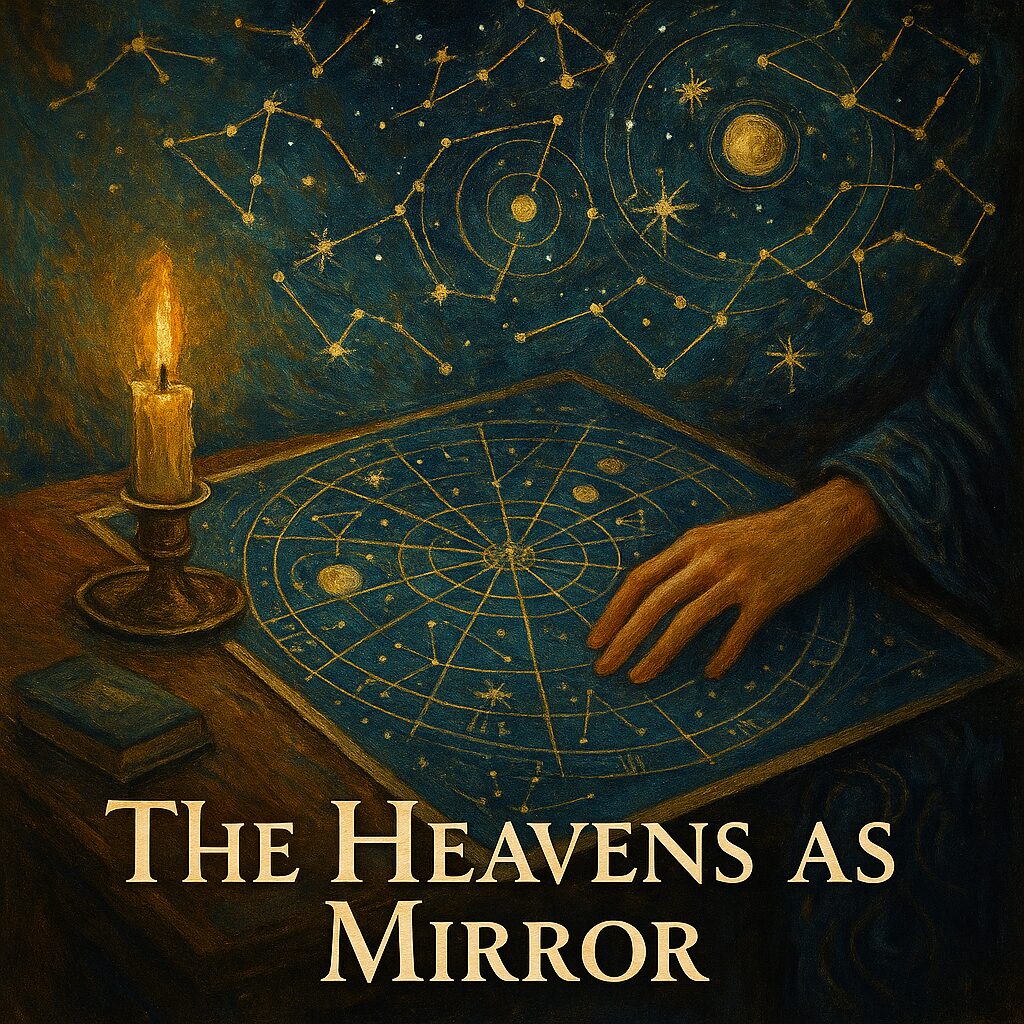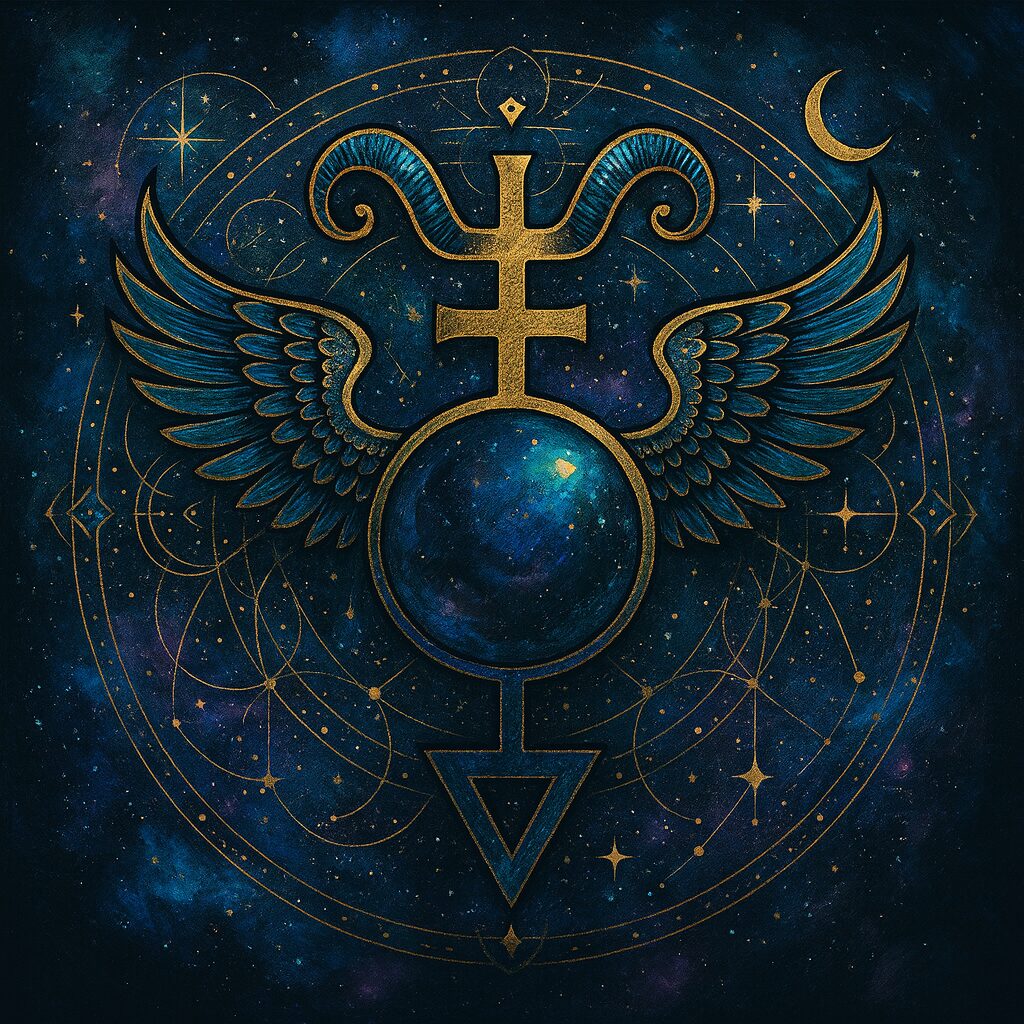
To read the stars is to read the oldest text — a script written before language, before firelight, before myth itself. Long before humankind inscribed symbols on clay or card, we lifted our eyes upward and found meaning among the lights that moved. The sky was the first oracle: vast, recurring, alive with pattern. From its turning the ancients learned rhythm, from its anomalies, omen. Astrology was thus born — not as science or superstition, but as divination in its purest form: the art of perceiving the signature of spirit within the motions of the cosmos.
At its heart, astrology is a theology of correspondence. The maxim as above, so below — Hermetic, eternal — describes its entire method. The heavens and the earth are reflections of one another, the visible and invisible woven together in a single pattern of meaning. The astrologer’s work is to interpret the relationship between celestial motion and human experience, to read the rhythm of the macrocosm within the microcosm of the soul. Every planet becomes a power, every sign a mode of expression, every aspect a dialogue between forces. The chart is not a machine of fate, but a mirror of becoming.
Historically, astrology has always been a divinatory art before it was a predictive one. In ancient Mesopotamia, where the practice first took shape, priests observed the heavens to discern divine will, not to calculate probability. The Babylonians saw eclipses, conjunctions, and comets as messages from the gods to the kingdom — celestial correspondences to earthly affairs. In Egypt, the movement of Sirius marked the Nile’s flood and therefore the rhythm of all life. The Greeks, refining astrology through geometry and philosophy, transformed it into a symbolic language of soul. Ptolemy’s Tetrabiblos systematized this vision: the planets became archetypes, their interplay a grammar of destiny.
Yet astrology’s greatest strength as divination lies not in its charts or tables, but in its symbolism — its capacity to reveal inner truth through outward pattern. The birth chart is not an instruction manual for the self but a mirror held to the psyche. When the astrologer interprets planetary aspects, she is not predicting inevitabilities but uncovering resonances: the moods of fate, the potential energies that shape one’s story. In this, astrology functions as revelation, not fortune-telling — it describes the climate of possibility, not the forecast of certainties.
This is where astrology aligns most closely with other divinatory arts. Like Tarot or scrying, it invites reflection rather than command; it speaks in symbols rather than absolutes. A natal chart, like a spread of cards, offers a pattern that must be read intuitively as well as intellectually. The astrologer listens not only to ephemerides and degrees, but to the subtle voice that rises through them. The stars provide the alphabet; the diviner reads the poetry that the moment composes.
In practice, astrologers use several modes of divination, each tuned to a different kind of question. Natal astrology reveals the soul’s architecture — the divine pattern imprinted at the first breath. Horary astrology answers specific inquiries by casting a chart for the exact moment a question is asked, allowing the astrologer to interpret how the heavens respond. Electional astrology selects auspicious times for action, weaving the will of the witch with the rhythm of the cosmos. Mundane astrology reads the fate of nations, eclipses, and great conjunctions — echoes of the collective psyche written in planetary cycles. Each method seeks not control, but alignment: to act in harmony with cosmic motion rather than against it.
Within witchcraft and Wiccan practice, astrology often serves as both divinatory and ritual compass. The phases of the moon guide spellwork; planetary hours and days align the witch’s intent with the appropriate current. To cast a chart before a working is to attune one’s energy to the celestial tide — to know when the heavens are fertile, when they are still, and when they turn inward. Even beyond the technical, astrology shapes the witch’s worldview: it reminds her that magic is relational, that every act on earth participates in a larger dance above.
Yet, as with all forms of divination, astrology’s power rests not in its precision but in its poetry. Its symbols do not describe causation but correlation; they do not bind, they reflect. The planets influence only insofar as we resonate with them — not as puppets of gravity, but as participants in pattern. To treat astrology as determinism is to miss its essence. True astrological divination is contemplative: it invites the practitioner to see themselves as a node in the vast conversation of being. The chart does not predict what will occur; it reveals the way energies move through us, and how consciousness might respond.
This is also astrology’s limit — and its wisdom. It cannot foretell every event, for it is not fortune-telling in the mechanistic sense. The sky is archetypal, not literal. The same aspect may manifest as conflict or transformation, depending on the will of the soul. The stars incline; they do not compel. The diviner’s task is not to deliver decree, but to awaken awareness: to illuminate the paths that shimmer under the same constellation, and to help the seeker choose their own.
In this way, astrology occupies a unique threshold between mysticism and method. It requires discipline and calculation — the geometry of the heavens, the precision of ephemerides — yet its true insight arises in trance and intuition. The astrologer, like the witch, reads pattern through both eye and spirit. She may spend years mastering the houses and aspects, but the moment of revelation — when a chart suddenly speaks — is always an act of grace. The mathematics dissolve, and what remains is divination: that electric moment when symbol becomes soul.
Ultimately, astrology endures because it restores meaning to motion. In a world that often feels random, it offers coherence — not by controlling the future, but by sanctifying the present. To see the heavens as mirror is to remember that the divine is not elsewhere, but everywhere. Each rising moon, each retrograde, each eclipse is an echo of our own becoming.
Astrology, when practiced as divination, is thus not about prediction but participation. It is the art of standing between heaven and earth and recognizing the conversation already taking place. To read the chart is to read the moment — to understand that every breath is timed to a cosmic rhythm, and every soul, like every star, burns according to its own mysterious geometry.
And so the astrologer looks upward, not to escape the world, but to enter it more deeply — to hear, in the silence between constellations, the whisper of the infinite saying: As above, so below; as within, so without.

